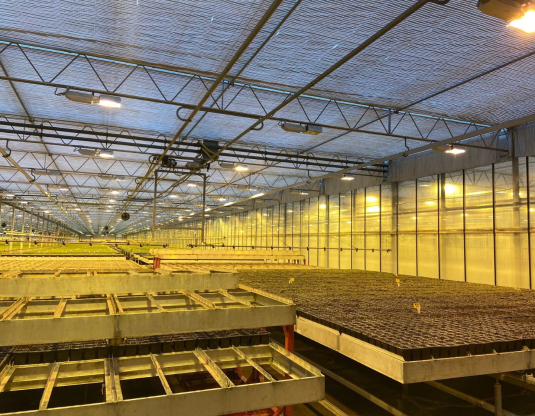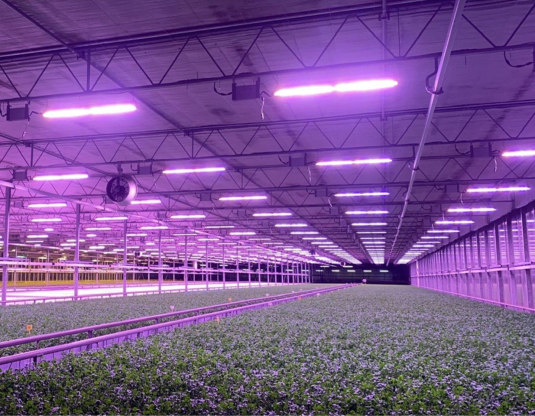The Client
Lincolnshire Herbs is one of the largest growers of fresh cut and living pot herbs in the UK, supplying UK Supermarkets, other retail outlets, food service brands, wholesale markets and manufacturing.
It is part of a privately owned European group of companies specialising in the growing, packing and distribution of fresh herbs. The Spisa Group is the largest grower and supplier of fresh and living herbs, supplying retail and food service markets across Europe.
Lincolnshire Herbs is committed to reducing its impact on the environment, ensuring the sustainability of the growing process and operations, partnering with leading supermarket brands to reduce plastics usage. The company is always looking for new ways to innovate, and recently installed a pioneering heating system, cutting carbon emissions by 50%, as part of its long-term carbon-reduction plan.


The Brief
Lincolnshire Herbs had the goal of reducing energy consumption through replacing the existing High Pressure Sodium lighting, whilst increasing product quality and yield through wavelength-specific LED implementation
The company requested a full tender specification and at the same time tasked SaveMoneyCutCarbon with applying for and achieving £500K of grant funding from the Rural Payments Agency (RPA) to support the capital costs.
The Solution
The new LED lamps installed by SaveMoneyCutCarbon’s Demand Reduction team provide twice the amount of light energy compared to the HPS Lamps whilst reducing energy consumption by 25%, resulting in energy savings and increased yield.
SaveMoneyCutCarbon tendered the performance specification in order to select the most effective manufacturer and worked with the Spisa Group plant scientists to establish the optimum specification – average Photosynthetic Photon Flux Density (PPFD), spectral density, and other metrics based on the client’s crop.
The optimal target was finalised through relevant case study reviews, then developing a number of design iterations simulating various light products and layouts.
A key element throughout was the focus on balancing energy savings to ensure that the business case for investment in the new lighting remained compelling.
LED for growth


The required specification was to achieve a desired target average Photosynthetic Photon Flux Density (PPFD) of 160umol/m2/s. The legacy 600-watt High Pressure Sodium (HPS) lamps were averaging 90umol/m2/s. PPFD can be broadly defined as the number of photosynthetically active photons that land on the plant surface every second.
Increasing the PPFD level provides plants with a higher intensity of light, which acts as the energy source for photosynthesis. This increased light intensity stimulates the plant’s chlorophyll molecules.
Chlorophyll molecules are like special “energy collectors”. They are what make plants green. and collect light from the sun to use it to make food for the plant. By collecting solar energy, chlorophyll molecules function like miniature power stations.
Increasing the intensity of the light allows plants to capture more photons and convert them into chemical energy through photosynthesis, with more sugars and carbohydrates produced, fuelling faster plant growth, and ultimately leading to improved yields in indoor herb cultivation.
The team also paid close attention the products’ preferred Spectrum Photon Distribution (SPD), selecting a broad pink type-B PKB range to ensure that the most effective approach for the range of products, with the majority in the red spectrum, and an even distribution between green and blue.
Red light wavelengths (particularly around 660nm) encourage stem, leaf, and general vegetative growth – but most commonly, tall, stretching of leaves and flowers. A balanced pairing with blue light is necessary to counteract any overstretching, like disfigured stem elongation. The green light helps with photosynthesis and stimulate improvements in plant size, weight and growth factors. So, getting this balance right was important.


With the growth efficiency and energy saving data gathered, Lincolnshire Herbs commissioned SaveMoneyCutCarbon to replace 2928 HPS lamps with high efficiency, wavelength specific LED units, GE Arize R100 PKB. The installation team also upgrading sections of the growing environment to three-phase supplies, along with integration into the existing controls system.
SaveMoneyCutCarbon provided a full energy and carbon-focused Engineering, Procurement and Construction (EPC) contract methodology, which provided Lincolnshire Herbs with peace of mind, while driving best value, demonstrating the detail of improved yield output vs energy consumption and cost.
The Demand Reduction team delivered a programme of development, engaging with Lincolnshire Herbs at key gateways, including specifications, tender outcomes, pricing, and delivery models.
By adopting the approach of acting effectively as agent for Lincolnshire Herbs, SaveMoneyCutCarbon met all challenges and provided multiple benefits including:
LED lighting retrofits require specialised knowledge and expertise. Partnering with SaveMoneyCutCarbon ensured Lincolnshire Herbs had access to an experienced engineering and procurement team who have years of experience in the industry and understand the intricacies and best practices associated with LED lighting systems.
Adopting this methodology allowed Spisa, Lincolnshire Herbs and the Demand Reduction engineering team to develop a consistent specification across all sites. This ensures that the lighting products and components tendered and ultimately selected met the prescribed requirements, including PPFD, energy efficiency, SPD, lumen outputs, controls and control strategy and compatibility with existing infrastructure.
In addition to the core requirements and benefits, this approach also significantly simplifies maintenance and replacement efforts in the future, including clear approach to spares provisioning, providing economies of scale and simplified lifecycle procurement.
Coordinating a retrofit project of this scale and in an active environment can be complex and time-consuming. The dedicated team oversaw the project from start to finish, ensuring consistency, adherence to timelines, and effective communication.
The qualified Association for Project Management (APM) project management team utilised industry best practice methodologies to ensure, effective mobilisation and communication, risk management, Quality Assurance, schedule adherence and, above all, professionalism.
Through this process SaveMoneyCutCarbon worked closely with Lincolnshire Herbs to coordinate a programme that minimised disruption and downtime during the retrofit. As part of the development and tender process, the dedicated team worked with Lincolnshire Herbs to develop a well-structured implementation plan, ensuring that the work was carried out efficiently, causing minimal interference with daily operations.
Impact Pro, SaveMoneyCutCarbon’s client platform, allows for centralised documentation and reporting, making it easier to:
- track progress
- manage project milestones
- generate comprehensive reports (for business case and IGP development/presentation)
- demonstrate benefits realisation.
Going forward, the platform should form an important element in the streamlining of further sustainability projects at Lincolnshire Herbs.
Grant funding
SaveMoneyCutCarbon fully supported and guided Lincolnshire Herbs through the highly technical RPA grant application process to gain funding for the LED lighting project. The grant provides around 30% of total project value and is paid in phases.


Savings Summary
-
£290,000
£ saved
-
270 tonnes
tonnes
-
935,452 kwh
kWh